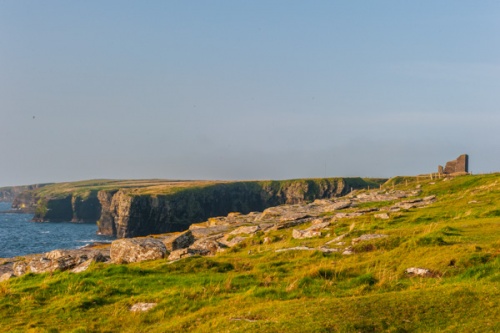
The Castle of Old Wick dates to the 12th century, making it one of the earliest castles in Scotland and certainly one of the best-preserved Norse fortifications.
It was probably built by Harald Maddadson, Earl of Orkney and Caithness, around 1160. Earl Harald was half Norse, half Scottish, and Old Wick may have been his chief residence on the Scottish mainland. What we see today is the tower, which would have provided for storage on the ground floor, with the hall above, and private chambers for the Earl and his family higher still.

The only entrance was by a ladder to the first-floor hall, on the seaward side, but the wall on this side has collapsed, so you enter through a gap in the walls into the ground floor storage area. There is no internal trace of stairs, so people must have had to use ladders to climb from floor to floor. There are no signs of fireplaces, either, so the rooms must have been heated by central braziers.
What we can't really see is the range of outbuildings that would have covered the promontory, from a kitchen to bakehouses, stables, a brewery, workshops and quarters for servants and retainers.

The promontory was defended on the landward side by a ditch, spanned by a drawbridge, with a gatehouse on the landward side.
We know very little about the castle's early history, but we do know that during the Scottish Wars of Independence in the early 14th century Old Wick was held by Sir Reginald de Cheyne, a supporter of the English king, Edward I.

Visiting
The castle is well signposted off the A99 in the centre of Wick. Signposts lead you to the shore road, heading south to a small car park at the end of the road. From there, an obvious trail leads along the cliffs to the castle, 800 yards away. The going is very easy, and you really can't miss the castle; it is obvious from quite a long ways away.
Old Wick is an open-access site, but please note that the castle stands within an MOD firing range. There is a quite obvious flagpole near a stile about halfway between the car park and the castle. If the site is off-limits due to MOD activity, a red flag will fly from the mast.
At any other time the castle is quite safe to visit, just be careful to not wander close to the cliff edge! There is a single information panel just before you get to the castle, but no further signs to help you get an idea of the site.

The entire visible castle consists of a single ruined tower, with a low, barred window on one side and obvious blocked openings for narrow windows on two other sides. Inside the tower, you can see the holes where timbers once divided the interior into several floors.
What is really striking about the castle is the location; right on the edge of the cliffs, with a sheer drop on two sides and a narrow promontory leading to cliffs on the seaward side. It must have been a very easy site to defend, for you really only had to watch the landward approaches.
As castles go, Old Wick offers very little in terms of tangible remains, but it more than makes up for that shortcoming with the wonderful clifftop location!





 We've 'tagged' this attraction information to help you find related historic attractions and learn more about major time periods mentioned.
We've 'tagged' this attraction information to help you find related historic attractions and learn more about major time periods mentioned.




